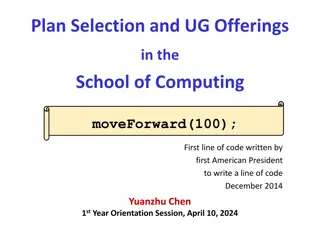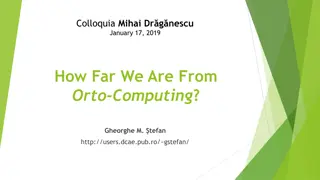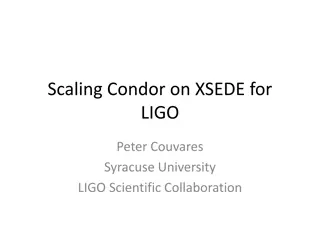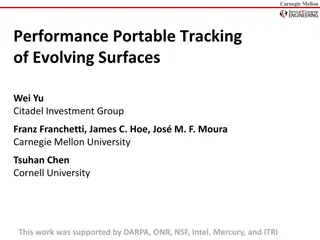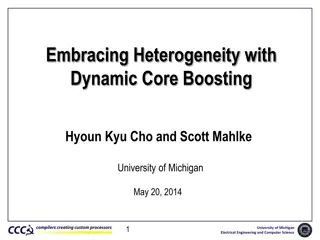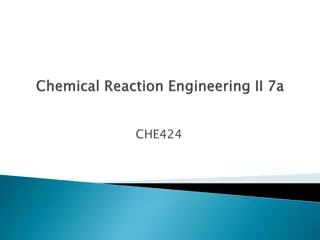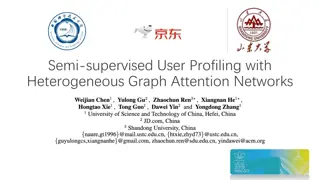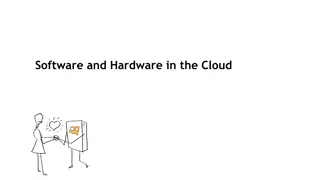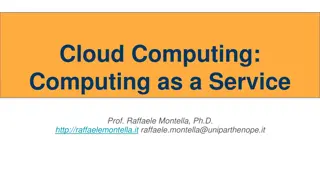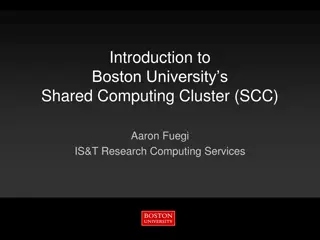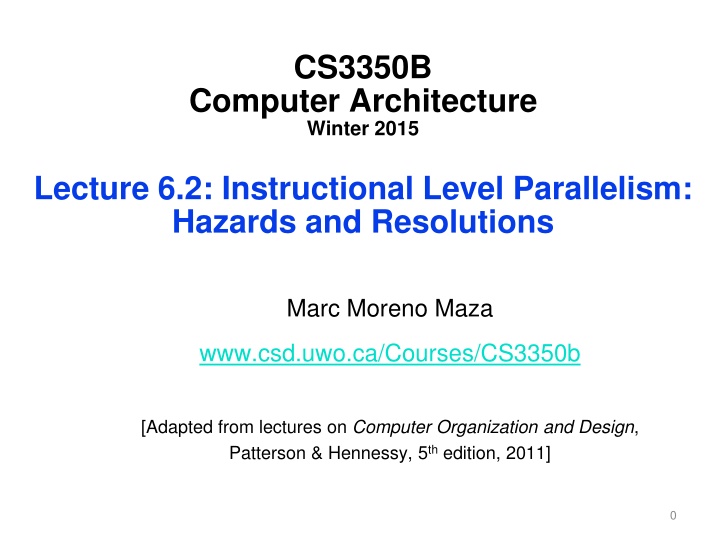
Heterogeneous Computing with D
This content delves into the world of heterogeneous computing with D, focusing on GPU architecture, development models, applications, challenges for developers, and LLVM support. It covers topics such as single instruction multiple thread (SIMT), memory types, development flows, and more.
Download Presentation

Please find below an Image/Link to download the presentation.
The content on the website is provided AS IS for your information and personal use only. It may not be sold, licensed, or shared on other websites without obtaining consent from the author. If you encounter any issues during the download, it is possible that the publisher has removed the file from their server.
You are allowed to download the files provided on this website for personal or commercial use, subject to the condition that they are used lawfully. All files are the property of their respective owners.
The content on the website is provided AS IS for your information and personal use only. It may not be sold, licensed, or shared on other websites without obtaining consent from the author.
E N D
Presentation Transcript
CS3350B Computer Architecture Winter 2015 Lecture 6.2: Instructional Level Parallelism: Hazards and Resolutions Marc Moreno Maza www.csd.uwo.ca/Courses/CS3350b [Adapted from lectures on Computer Organization and Design, Patterson & Hennessy, 5thedition, 2011] 0
Recap: Pipelining for Performance All modern day processors use pipelining Pipelining doesn t help latency of single task, it helps throughput of entire workload Potential speedup: CPI=?, and a faster CC Recall CPU time = CPI * CC * IC Pipeline rate limited by slowest pipeline stage Unbalanced pipe stages make for inefficiencies The time to fill pipeline and time to drain it can impact speedup for deep pipelines and short code runs Must detect and resolve hazards Can always resolve hazards by waiting (Stalling) Stalling negatively affects CPI (makes CPI more than the ideal of 1) 1
Three Types of Pipeline Hazards Structural hazards Attempt to use the same resource by two different instructions at the same time Data hazards (from what types of instructions?) Attempt to use data before it is ready in instructions involving arithmetic and data transfers - An instruction s source operand(s) are produced by a prior instruction still in the pipeline Control hazards Attempt to make a decision about program control flow before the condition has been evaluated and the new PC target address calculated; branch instructions Can always resolve hazards by waiting (makes CPI > 1) Better to have pipeline control to detect the hazards and take action to resolve hazards more efficiently 2
Structural Hazard #1: in case of Single Memory Time (clock cycles) Reading data from memory lw ALU Mem Mem Reg Reg I n s t r. Inst 1 ALU Mem Mem Reg Reg ALU Inst 2 Mem Reg Reg O r d e r Mem ALU Inst 3 Mem Mem Reg Reg ALU Mem Inst 4 Mem Reg Reg Reading instruction from memory Read same memory twice in same clock cycle 3
Structural Hazard #1: Fix with separate instruction and data memories (I$ and D$) Time (clock cycles) I n s t r. ALU I$ D$ Reg Reg lw ALU I$ D$ Reg Reg Instr 1 ALU I$ D$ Reg Reg Instr 2 O r d e r ALU I$ D$ Reg Reg Instr 3 ALU I$ D$ Reg Reg Instr 4 4
Structural Hazard #2: Registers (1/2) Time (clock cycles) I n s t r . ALU I$ D$ Reg Reg lw ALU I$ D$ Reg Reg Instr 1 ALU I$ D$ Reg Reg Instr 2 O r d e r ALU I$ D$ Reg Reg Instr 3 ALU I$ D$ Reg Reg Instr 4 Can we read and write to registers simultaneously? 5
Structural Hazard #2: Registers (2/2) Two different solutions have been used: (1) RegFile access is very fast: takes less than half the time of ALU stage - Write to Registers during first half of each clock cycle - Read from Registers during second half of each clock cycle (2) Build RegFile with independent read and write ports Result: can perform register Read and Write during same clock cycle 6
Data Hazard Type 1 (1/2) Consider the following sequence of instructions add $t0, $t1, $t2 sub $t4, $t0, $t3 and $t5, $t0, $t6 or $t7, $t0, $t8 xor $t9, $t0, $t10 Q1: What are the dependences ? $t0 of sub depends on $t0 of add; Read After Write (RAW) $t0 of and depends on $t0 of add; RAW $t0 of or depends on $t0 of add; RAW $t0 of xor depends on $t0 of add; RAW Q2: Are there any hazards? We use pipeline diagram to analyze it. 7
Data Hazard Type 1 (2/2) Data-flow backward in time are hazards. This case is a read before write data hazard. Time (clock cycles) I CC1 CC2 CC3 CC4 CC5 CC6 CC7 CC8 CC9 n s t r. IF ID/RF EX ALU MEM WB add $t0,$t1,$t2 Reg Reg I$ D$ ALU sub $t4,$t0,$t3 I$ D$ Reg Reg O r d e r ALU I$ D$ Reg and $t5,$t0,$t6 Reg ALU I$ D$ Reg Reg or $t7,$t0,$t8 ALU I$ D$ Reg Reg xor $t9,$t0,$t10 8
Data Hazard Solution 1: Stall (Waiting) Stall, or bubble, or nop; no backward data flow anymore CC1 CC2 CC3 CC4 CC5 CC6 CC9 CC10CC11 CC7 CC8 IF ID/RF EX ALU MEM WB I add $t0,$t1,$t2 n s t r. Reg Reg I$ D$ bubble bubble bubble bubble stall bubble bubble bubble bubble bubble bubble stall O r d e r ALU I$ D$ Reg Reg sub $t4,$t0,$t3 ALU I$ D$ Reg Reg and $t5,$t0,$t6 ALU or $t7,$t0,$t8 I$ D$ Reg Reg ALU I$ D$ Reg Reg xor $t9,$t0,$t10 How many cycles? What s the CPI now? 11/5 9
Data Hazard Solution 2: Forwarding (aka Bypassing) Hardware forwards result to the stage needed as soon as it is available (bypassing the register) - ALU-ALU forwarding in this case - Hardware: hazard detection unit; forward unit or hazard solved by register hardware CC1 CC2 CC3 CC4 CC5 CC6 CC7 CC8 CC9 IF I$ ID/RF Reg EX MEM ALU WB Reg add $t0,$t1,$t2 D$ ALU sub $t4,$t0,$t3 I$ D$ Reg Reg ALU I$ D$ Reg and $t5,$t0,$t6 Reg ALU I$ D$ Reg Reg or $t7,$t0,$t8 ALU I$ D$ Reg Reg xor $t9,$t0,$t10 10 How many cycles? What is the CPI now? 9/5
Yet Another Complication! Another potential data hazard can occur when there is a conflict between the result of the WB stage instruction and the MEM stage instruction which should be forwarded? I add $1,$1,$2 ALU IM DM Reg Reg n s t r. add $1,$1,$3 ALU IM DM Reg Reg O r d e r add $1,$1,$4 ALU IM DM Reg Reg
Data Hazard Type 2: Load/Use (1/2) Dataflow backwards in time are hazards CC1 CC2 CC3 CC4 CC5 CC6 CC7 IF ID/RF Reg EX ALU MEM WB Reg lw $t0,0($t1) I$ D$ ALU sub $t3,$t0,$t2 I$ D$ Reg Reg 12
Data Hazard Type 2: Load/Use (2/2) Is it feasible to fix it by just forwarding? i.e. when the data is loaded from D$ before writing to the register, forward it to ALU for sub. CC1 CC2 CC3 CC4 CC5 CC6 CC7 ID/RF Reg EX MEM ALU WB Reg IF lw $t0,0($t1) I$ D$ ALU sub $t3,$t0,$t2 I$ D$ Reg Reg Oops! Still a backward data flow! Can we go back in time? Must stall instruction dependent on load, then forward (more hardware) 13
Load/Use Data Hazard: Solution Option 1 Hardwaredetects hazard, stalls pipeline (Called interlock ), and forward (MEM-ALU forwarding). CPI = ? 9/4 CC9 IF ID/RF EX ALU MEM WB lw $t0, 0($t1) Reg Reg I$ D$ bub ble ALU sub $t3,$t0,$t2 I$ D$ Reg Reg bub ble ALU I$ D$ Reg Reg and $t5,$t0,$t4 bub ble ALU or $t7,$t0,$t6 I$ D$ Reg Reg Not in MIPS: (MIPS = Microprocessor without Interlocked Pipeline Stages) 14
Load/Use Data Hazard Solution Option 2 Insert nop (equivalent to stall) and forward lw $t0, 0($t1) ALU Reg Reg I$ D$ bub ble bub ble bub ble bub ble bub ble nop ALU Reg Reg sub $t3,$t0,$t2 I$ D$ and $t5,$t0,$t4 ALU Reg Reg I$ D$ or $t7,$t0,$t6 ALU I$ D$ Reg 15
Remarks on Load/Use Data Hazard Instruction slot after a load is called load delay slot If that instruction uses the result of the load, then the hardware interlock will stall it for one cycle. Alternative: If the compiler puts an unrelated instruction in that slot, then no stall Letting the hardware stall the instruction in the delay slot is equivalent to putting a nop in the slot (except the latter uses more code space) 16
Load/Use Data Hazards: Code Scheduling to Avoid Stalls Reorder code to avoid use of load result in the next instruction (load delay slot) C code for A = B + E; /* $t3 = $t1 + $t2 */ C = B + F; /* $t5 = $t1 + $t4 */ lw $t1, 0($t0) lw $t2, 4($t0) lw $t4, 8($t0) add $t3, $t1, $t2 sw $t3, 12($t0) add $t5, $t1, $t4 sw $t5, 16($t0) lw $t1, 0($t0) lw $t2, 4($t0) add $t3, $t1, $t2 sw $t3, 12($t0) lw $t4, 8($t0) add $t5, $t1, $t4 sw $t5, 16($t0) stall stall 13 cycles 11 cycles 17
Memory-to-Memory Copies For loads immediately followed by stores (memory-to- memory copies) can avoid a stall by adding forwarding hardware from the MEM/WB register to the data memory input (MEM-MEM forwarding) Would need to add a Forward Unit and a mux to the memory access stage I n s t r. lw $1,4($2) ALU I$ D$ Reg Reg ALU I$ D$ Reg O r d e r sw $1,4($3) Reg
Control Hazards Branch determines flow of control Fetching next instruction depends on branch outcome The delay in determining the proper instruction to fetch is called a control hazard orbranch hazard. Pipeline can t always fetch correct instruction - Still working on ID stage of branch beq, bne in MIPS pipeline 19
Control Hazards Simple Solution Option 1: two Stalls Stallon every branch until have new PC value; Would add 2 bubbles/clock cycles for every Branch! Time (clock cycles) I EX n s t r. ALU I$ D$ Reg Reg beq nop nop bubble bubble bubble bubble bubble O r d e r bubble bubble bubble bubble bubble ALU Instr Instr I$ D$ Reg Reg ALU I$ D$ Reg Reg Where do we do the compare for the branch? 20
Control Hazard: Branching Optimization #1: Insert special branch comparator in Stage 2 (Dec) As soon as instruction is decoded (i.e. Opcode identifies it as a branch), immediately make a decision and set the new value of the PC Benefit: since branch is complete in Stage 2, only one unnecessary instruction is fetched, so only one no-op is needed Side Note: means that branches are idle in Stages 3, 4 and 5 21
Special Branch Comparator with One Clock Cycle Stall Time (clock cycles) ID/RF I ALU n s t r. I$ D$ Reg Reg beq nop bubble bubble bubble bubble bubble ALU I$ D$ Reg Reg Instr O r d e r ALU I$ D$ Reg Reg Instr ALU I$ D$ Reg Reg Instr Branch comparator moved to Decode stage 22
Performance of Stall on Branch Assume branches are 17% of the instructions executed in SPECint2006. Since the other instructions run have a CPI of 1, and branches took one extra clock cycle for the stall, then we would see a CPI of 1.17 and hence a slowdown of 1.17 versus the ideal case. 23
Control Hazards: Branch Delay Slot Optimization #2: Redefine branches Old definition: if we take the branch, none of the instructions after the branch get executed by accident New definition: whether or not we take the branch, the single instruction immediately following the branch gets executed (the branch-delay slot) Delayed Branch means we always execute the instruction after branch This optimization is used with MIPS. 24
Example: Nondelayed vs. Delayed Branch Nondelayed Branch Delayed Branch or $8, $9, $10 add $1, $2,$3 sub $4, $5, $6 add $1, $2, $3 beq $1, $4, Exit sub $4, $5, $6 or $8, $9, $10 beq $1, $4, Exit xor $10, $1, $11 xor $10, $1, $11 Exit: Exit: 25
Notes on Branch-Delay Slot Worst-Case Scenario: put a no-op in the branch-delay slot Better Case: place some instruction preceding the branch in the branch-delay slot as long as the changed doesn t affect the logic of program - Re-ordering instructions is common way to speed up programs - Compiler usually finds such an instruction 50% of time - Jumpsalso have a delay slot Since delayed branches are useful when the branches are short, no processor uses a delayed branch of more than one cycle. For longer branch delays, hardware-based branch prediction is usually used. The delayed branch always executes the next sequential instruction, with the branch taking place after that one instruction delay. It is hidden from the MIPS assembly language programmer because the assembler can automatically arrange the instructions to get the branch behavior desired by the programmer. MIPS software will place an instruction immediately after the delayed branch instruction that is not affected by the branch, and a taken branch changes the address of the instruction that follows this safe instruction. 26
Control Hazards: Branch Prediction Opt #3: Predictoutcome of a branch, fix up if guess wrong Must cancel all instructions in pipeline that depended on wrong- guess This is called flushing the pipeline Opt 3.1: Assume branches are NOT taken, continue execution down the sequential instruction stream. If the branch is taken, the instructions that are being fetched and decoded must be discarded. Execution continues at the branch target. If branches are untaken half the time, and if it costs little to discard the instructions, this optimization halves the cost of control hazards. Opt3.2: Dynamic branch prediction: Prediction of branches at runtime using runtime information. branch prediction buffer or branch history table 27
In Summary: Hazards and Resolutions Structural Hazards Memory: I$ and D$ are separated Register: read and write can be done in same clock cycle Data Hazards load followed by store: MEM-MEM forwarding load/use - Hardware interlock (stall pipeline) and MEM-ALU forwarding - load delay slot: put a nop or a valid instruction after load (MIPS) other cases: one stall (nop) plus ALU-ALU forwarding Hardware support: hazard detection unit and forward unit Control hazards stall two cycles if branch execution done in EX stage stall one cycle if branch execution done in ID stage branch delay slot: put a nop (one cycle waste) or a valid instruction after branch (MIPS) (branch execution in ID) branch predication: branch not taken or dynamic predication How does a hazard solution impact the pipeline performance? 28
Exercise 1 For the following code sequence in MIPS, Indicate the dependences Indicate the potential hazards and types Provide your hazard resolution methods and show how many extra clock cycles you have to pay. sub $2, $1,$3 # Register $2 written by sub and $12,$2,$5 # 1st operand($2) depends on sub or $13,$6,$2 # 2nd operand($2) depends on sub add $14,$2,$2 # 1st($2) & 2nd($2) depend on sub sw $15,100($2) # Base ($2) depends on sub 29
Exercise 2 Show what happens when the branch is taken in this instruction sequence, assuming the pipeline is optimized for branches that are not taken and that we moved the branch execution to the ID stage. The numbers to the left of the instruction (40, 44, . . . ) are the addresses of the instructions. 36 sub $10, $4, $8 40 beq $1, $3, 7 # PC-relative branch to 40 + 4 + 7 * 4 = 72 44 and $12, $2, $5 48 or $13, $2, $6 52 add $14, $4, $2 56 slt $15, $6, $7 72 lw $4, 50($7) 30

